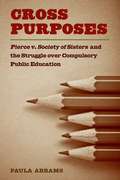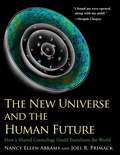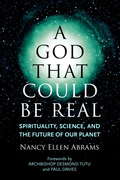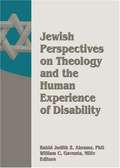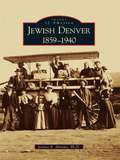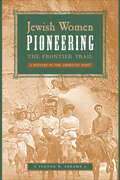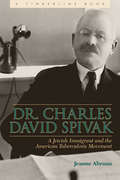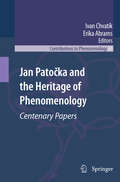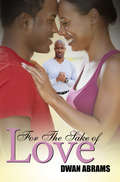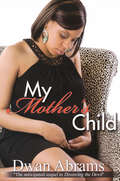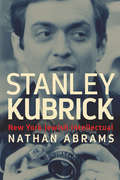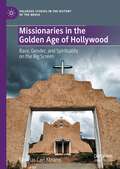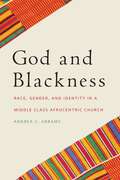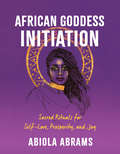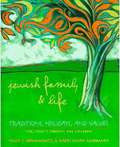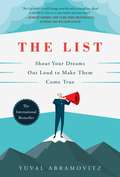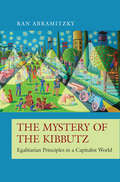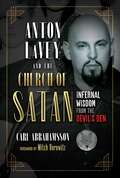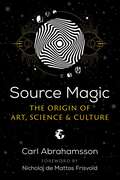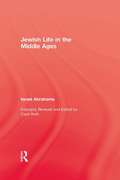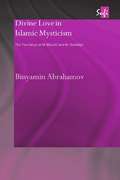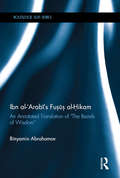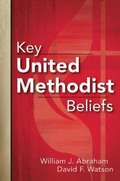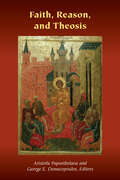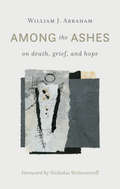- Table View
- List View
Cross Purposes: Pierce v. Society of Sisters and the Struggle over Compulsory Public Education
by Paula Abrams"A definitive study of an extremely important, though curiously neglected, Supreme Court decision,Pierce v. Society of Sisters. " ---Robert O'Neil, Professor of Law Emeritus, University of Virginia School of Law "A careful and captivating examination of a dramatic and instructive clash between nationalism and religious pluralism, and of the ancient but ongoing struggle for control over the education of children and the formation of citizens. " ---Richard W. Garnett, Professor of Law and Associate Dean, Notre Dame Law School "A well-written, well-researched blend of law, politics, and history. " ---Joan DelFattore, Professor of English and Legal Studies, University of Delaware In 1922, the people of Oregon passed legislation requiring all children to attend public schools. For the nativists and progressives who had campaigned for the Oregon School Bill, it marked the first victory in a national campaign to homogenize education---and ultimately the populace. Private schools, both secular and religious, vowed to challenge the law. The Catholic Church, the largest provider of private education in the country and the primary target of the Ku Klux Klan campaign, stepped forward to lead the fight all the way to the U. S. Supreme Court. InPierce v. Society of Sisters(1925), the court declared the Oregon School Bill unconstitutional and ruled that parents have the right to determine how their children should be educated. Since then, Pierce has provided a precedent in many cases pitting parents against the state. Paula Abrams is Professor of Constitutional Law at Lewis & Clark Law School.
The New Universe and the Human Future: How a Shared Cosmology Could Transform the World (The Terry Lectures Series) (The Terry Lectures Series)
by Nancy Ellen Abrams Joel R. PrimackA cultural philosopher and an astrophysicist attempt to decipher how we fit into the universe, and the impact our placement has on us. After a four-century rupture between science and the questions of value and meaning, this groundbreaking book presents an explosive and potentially life-altering idea: if the world could agree on a shared creation story based on modern cosmology and biology—a story that has just become available—it would redefine our relationship with Planet Earth and benefit all of humanity, now and into the distant future.Written in eloquent, accessible prose and illustrated in magnificent color throughout, including images from innovative simulations of the evolving universe, this book brings the new scientific picture of the universe to life. It interprets what our human place in the cosmos may mean for us and our descendants. It offers unique insights into the potential use of this newfound knowledge to find solutions to seemingly intractable global problems such as climate change and unsustainable growth. And it explains why we need to &“think cosmically, act globally&” if we're going to have a long-term, prosperous future on Earth.&“Should be read by anyone, not just scientists, who worry about the human condition.&”—Deepak Chopra, The Huffington Post&“A prophetic book. Its message ranks right up there with those of Isaiah, Jeremiah, Ezekiel, and Joel. Like the prophets, it is at times poetic, demanding, grounded, soaring, empowering, and always awe-inspiring.&”—Matthew Fox, Tikkun&“The ideas and images are fascinating and certainly contribute to a sense of the profound stakes involved in what we&’re doing to the planet and ourselves.&”—William Kowinski, North Coast Journal
A God That Could Be Real
by Nancy Abrams Paul Davies Archbishop Desmond TutuA paradigm-shifting blend of science, religion, and philosophy for agnostic, spiritual-but-not-religious, and scientifically minded readers Many people are fed up with the way traditional religion alienates them: too easily it can perpetuate conflict, vilify science, and undermine reason. Nancy Abrams, a philosopher of science, lawyer, and lifelong atheist, is among them. And yet, when she turned to the recovery community to face a personal struggle, she found that imagining a higher power gave her a new freedom. Intellectually, this was quite surprising. Meanwhile her husband, famed astrophysicist Joel Primack, was helping create a new theory of the universe based on dark matter and dark energy, and Abrams was collaborating with him on two books that put the new scientific picture into a social and political context. She wondered, "Could anything actually exist in this strange new universe that is worthy of the name 'God?'" In A God That Could Be Real, Abrams explores a radically new way of thinking about God. She dismantles several common assumptions about God and shows why an omniscient, omnipotent God that created the universe and plans what happens is incompatible with science--but that this doesn't preclude a God that can comfort and empower us. Moving away from traditional arguments for God, Abrams finds something worthy of the name "God" in the new science of emergence: just as a complex ant hill emerges from the collective behavior of individually clueless ants, and just as the global economy emerges from the interactions of billions of individuals' choices, God, she argues, is an "emergent phenomenon" that arises from the staggering complexity of humanity's collective aspirations and is in dialogue with every individual. This God did not create the universe--it created the meaning of the universe. It's not universal--it's planetary. It can't change the world, but it helps us change the world. A God that could be real, Abrams shows us, is what humanity needs to inspire us to collectively cooperate to protect our warming planet and create a long-term civilization.From the Hardcover edition.
Jewish Perspectives on Theology and the Human Experience of Disability
by Judith Z. Abrams William C. GaventaFew people are untouched by the issue of disability, whether personally or through a friend or relative. Jewish Perspectives on Theology and the Human Experience of Disability shares moving insights from around the world and across the broad spectrum of Judaism on how and why the Jewish community is incomplete without the presence and participation of the disabled. Authors representing each of the three main movements of Judaism--Orthodox, Conservative, and Reform--examine theology, scripture, ethics, practical theology, religious education, and personal experience to understand and apply the lessons and wisdom of the past to issues of the present.
Jewish Denver: 1859-1940 (Images of America)
by Jeanne E. AbramsIn 1859, during the Pike's Peak gold rush, at least 12 Jews joined the great migration to Colorado in search of gold and a brighter future. The unpredictability of mining and a growing demand for supplies encouraged many of these Jewish settlers to establish small businesses in Denver and in towns and mining camps across the state. By the early 1870s, Jewish benevolent societies and a congregation were established. Denver's dry, mild climate attracted patients with tuberculosis, and two Jewish sanatoriums were opened in the city around the beginning of the 20th century. Many of the predominantly Eastern European Jews who came in search of better health made Denver their home, thus augmenting the early Jewish population significantly. Today Jewish life flourishes in Colorado, and Jewish citizens continue to play a vital role in its culture and development.
Jewish Women Pioneering the Frontier Trail: A History in the American West
by Jeanne E AbramsThe image of the West looms large in the American imagination. Yet the history of American Jewry and particularly of American Jewish women—has been heavily weighted toward the East. Jewish Women Pioneering the Frontier Trail rectifies this omission as the first full book to trace the history and contributions of Jewish women in the American West.In many ways, the Jewish experience in the West was distinct. Given the still-forming social landscape, beginning with the 1848 Gold Rush, Jews were able to integrate more fully into local communities than they had in the East. Jewish women in the West took advantage of the unsettled nature of the region to “open new doors” for themselves in the public sphere in ways often not yet possible elsewhere in the country. Women were crucial to the survival of early communities, and made distinct contributions not only in shaping Jewish communal life but outside the Jewish community as well. Western Jewish women's level of involvement at the vanguard of social welfare and progressive reform, commerce, politics, and higher education and the professions is striking given their relatively small numbers.This engaging work—full of stories from the memoirs and records of Jewish pioneer women—illuminates the pivotal role these women played in settling America's Western frontier.
Dr. Charles David Spivak: A Jewish Immigrant and the American Tuberculosis Movement (Timberline Books)
by Jeanne AbramsPart biography, part medical history, and part study of Jewish life in turn-of-the-century America, Jeanne Abrams's book tells the story of Dr. Charles David Spivak - a Jewish immigrant from Russia who became one of the leaders of the American Tuberculosis Movement. Born in Russia in 1861, Spivak immigrated to the United States in 1882 and received his medical degree from Philadelphia's Jefferson Medical College by 1890. In 1896, his wife's poor health brought them to Colorado. Determined to find a cure, Spivak became one of the most charismatic and well-known leaders in the American Tuberculosis Movement. His role as director of Denver's Jewish Consumptives' Relief Society sanatorium allowed his personal philosophies to strongly influence policies. His unique blend of Yiddishkeit, socialism, and secularism - along with his belief in treating the "whole" patient - became a model for integrating medical, social, and rehabilitation services that was copied across the country. Not only a national leader in the crusade against tuberculosis but also a luminary in the American Jewish community, Dr. Charles Spivak was a physician, humanitarian, writer, linguist, journalist, administrator, social worker, ethnic broker, and medical, public health, and social crusader. Abrams's biography will be a welcome addition to anyone interested in the history of medicine, Jewish life in America, or Colorado history.
Jan Patočka and the Heritage of Phenomenology
by Erika Abrams Ivan ChvatíkWhereas for the wider public Jan Patocka is known mainly as a defender of human rights and one of the first spokespersons of Charter 77, who died in Prague several days after long interrogations by secret police of the Communist regime, the international philosophical community sees in him an important and inspiring thinker, who in an original way elaborated the great impulses of European thought - mainly Husserl's phenomenology and Heidegger's philosophy of existence. Patocka also reflected on history and the future of humanity in a globalized world and laid the foundations of an original philosophy of history. His work is a subject of lively philosophical discussion especially in French and German-speaking countries, and recently also in Spanish-speaking, in U.S.A., and in the Far East. Scholars from around the world who are interested in the philosophy of Jan Patocka gathered in Prague to commemorate his centenary and the thirtieth anniversary of his death. The conference explored the significance of his work and its continuing influence on contemporary philosophy. The volume presents selected papers from the conference in English language.
For the Sake of Love
by Dwan AbramsSpade Spencer's life seems to be coming together. He's engaged to be married to the love of his life, Bria Murray, and he's an up and coming rapper who recently signed a major record deal. When Spade gets diagnosed with cancer, rather than lean on his fiancée for strength, he calls off the wedding, leaving Bria feeling alone and rejected. In an effort to move on with her life, Bria pours her energy into running her new company, The Spa Factory. Kerryngton Kruse, CEO of the record label that signed Spade, begins to pursue Bria romantically. Bria finally allows herself to develop feelings for Kerryngton, only to discover that Spade has different plans. Caught in the middle of a love triangle, Bria must make the difficult decision between love and money. Does she follow her heart and marry the one she can't live without, or does she marry for security, in hopes that love will eventually follow?
My Mother's Child
by Dwan AbramsLyric Stokes lives, by most standards, a charmed life. Married to Michael Stokes, a prominent heart surgeon, she has financial security and lives in the lap of luxury. All is not perfect, though. Lyric feels inadequate because she gave birth to a daughter, rather than the son that her husband so desperately wanted.After an unexpected turn of events, Lyric discovers that she's pregnant again, but now she has to decide whether she even wants to keep the child she has longed for. She seeks solace in her church, where her daughter also feels at home;but they can't get Michael to join them. Disagreeing with organized religion, he has put his job before all else, including God. The distance between the couple grows further every day.Nigel Fredericks has a history of stalking women. He's been accused, but never convicted. Now he's set his sights on Lyric. She's at a low point in her life, and Nigel knows just how to take advantage of that vulnerability. Lyric's life is turned upside down. Nigel is like a cancer eating away at her mental stability, her marriage, and ultimately, her life. Will Michael reevaluate his priorities and his faith in time to save his family?
Stanley Kubrick: New York Jewish Intellectual
by Dr Nathan AbramsStanley Kubrick is generally acknowledged as one of the world’s great directors. Yet few critics or scholars have considered how he emerged from a unique and vibrant cultural milieu: the New York Jewish intelligentsia. Stanley Kubrick reexamines the director’s work in context of his ethnic and cultural origins. Focusing on several of Kubrick’s key themes—including masculinity, ethical responsibility, and the nature of evil—it demonstrates how his films were in conversation with contemporary New York Jewish intellectuals who grappled with the same concerns. At the same time, it explores Kubrick’s fraught relationship with his Jewish identity and his reluctance to be pegged as an ethnic director, manifest in his removal of Jewish references and characters from stories he adapted. As he digs deep into rare Kubrick archives to reveal insights about the director’s life and times, film scholar Nathan Abrams also provides a nuanced account of Kubrick’s cinematic artistry. Each chapter offers a detailed analysis of one of Kubrick’s major films, including Lolita, Dr. Strangelove, 2001, A Clockwork Orange, Barry Lyndon, The Shining, Full Metal Jacket, and Eyes Wide Shut. Stanley Kubrick thus presents an illuminating look at one of the twentieth century’s most renowned and yet misunderstood directors.
Missionaries in the Golden Age of Hollywood: Race, Gender, and Spirituality on the Big Screen (Palgrave Studies in the History of the Media)
by Douglas Carl AbramsThis book examines major British and American missionary films during the Golden Age of Hollywood to explore the significance of race, gender, and spirituality in relation to the lives of the missionaries portrayed in film during the middle third of the twentieth century. Film both influences and reflects culture, and racial, gender, and religious identities are some of the most debated issues globally today. In the movies explored in this book, missionary interactions with various people groups reflect the historical changes which took place during this time.
God and Blackness: Race, Gender, and Identity in a Middle Class Afrocentric Church
by Andrea C. AbramsBlackness, as a concept, is extremely fluid: it can refer to cultural and ethnic identity, socio-political status, an aesthetic and embodied way of being, a social and political consciousness, or a diasporic kinship. It is used as a description of skin color ranging from the palest cream to the richest chocolate; as a marker of enslavement, marginalization, criminality, filth, or evil; or as a symbol of pride, beauty, elegance, strength, and depth. Despite the fact that it is elusive and difficult to define, blackness serves as one of the most potent and unifying domains of identity. God and Blackness offers an ethnographic study of blackness as it is understood within a specific community--that of the First Afrikan Church, a middle-class Afrocentric congregation in Atlanta, Georgia. Drawing on nearly two years of participant observation and in-depth interviews, Andrea C. Abrams examines how this community has employed Afrocentrism and Black theology as a means of negotiating the unreconciled natures of thoughts and ideals that are part of being both black and American. Specifically, Abrams examines the ways in which First Afrikan's construction of community is influenced by shared understandings of blackness, and probes the means through which individuals negotiate the tensions created by competing constructions of their black identity. Although Afrocentrism operates as the focal point of this discussion, the book examines questions of political identity, religious expression and gender dynamics through the lens of a unique black church.
African Goddess Initiation: Sacred Rituals for Self-Love, Prosperity, and Joy
by Abiola AbramsA sacred feminine initiation of self-love and soul care rituals, tools, and exercises.Spiritual teacher, intuitive coach, and award-winning author, Abiola Abrams invites you to activate African goddess magic to transmute your fears and limiting beliefs, so that you can create more happiness, abundance, and self-acceptance.Africa is a continent of 54+ countries, and her children are global. There is no one African spiritual tradition. Our ancestors who were trafficked in "The New World" hid the secrets of our orishas, abosom, lwas, álúsí, and god/desses behind saints, angels, and legendary characters. From South Africa to Egypt, Brazil to Haiti, Guyana to Louisiana, goddess wisdom still empowers us.Writes Abiola, "Spirit told me, "We choose who shows up." And if you are holding this book, then this sacred medicine is meant for you. In this book, you will meet ancient goddesses and divine feminine energy ancestors, legendary queens, and mystical spirits. As you complete their powerful rituals, and ascend through their temples, you will:. Awaken generational healing in the Temple of Ancestors;. Manifest your miracles in the Temple of Conjurers;. Release the struggle in the Temple of Warriors;. Embrace your dark goddess self in the Temple of Shadows;. Heal your primal wounds in the Temple of Lovers;. Liberate your voice in the Temple of Griots;. Open your third eye intuition in the Temple of Queens; and. Surrender, meditate, and rise in the Temple of High Priestesses.Welcome to your goddess circle!
Jewish Family and Life: Traditions, Holidays and Values for Today's Parents and Children
by Yosef I. Abramowitz Susan SilvermanJewish Family and Life: Traditions, Holidays, and Values for Today's Parents and Children has become the definitive book for parents to turn to for sound advice on important and current parenting issues. It dispenses invaluable information that is relevant to Jewish families today, whether the family has a mixed marriage, two parents, a single parent, or adoptive parents. The book's three parts--Traditions, Holidays and Values--investigate contemporary issues in raising children and show concrete ways in which Judaism can play a practical role in enriching a family's spiritual and moral education. Each chapter includes lively, hands-on activities that you can do with your kids and simultaneously instill vital cultural and religious education. Vetted by a prestigious advisory board that is co-chaired by Nobel Prize-winner Elie Weisel, this book with help unify the family and re-establish rich traditions that have been lost over the generations.
The List: Shout Your Dreams Out Loud to Make Them Come True
by Yuval AbramovitzRefreshingly honest, fast-paced, and full of humor, The List is full of practical advice and inspiration that will help you achieve your goals. Already an international bestseller, the book began as a list of 10 things the author wanted to accomplish in 400 days. He posted the list on his blog and asked for help—and within 24 hours was overwhelmed by responses. The key idea is as simple as it is powerful—let others know about your dreams and they will help you achieve them. Why do some people succeed where others fail? What makes some push past their financial hardships while others lag behind? What is holding you back? Yuval Abramovitz provides thought-provoking true stories, tips, insights, and techniques to show readers how to move past roadblocks, ask and receive help, and reach even the loftiest of goals. The List is filled with exercises and prompts for lists that help you make your dreams a reality. The author’s journey—from writing his first list in a wheelchair to becoming a well-known author, cultural reporter, actor, and media personality—and the stories of people around the world using his method to achieve success prove that this is a motivational book that truly works.
The Mystery of the Kibbutz: Egalitarian Principles in a Capitalist World
by Ran AbramitzkyHow the kibbutz movement thrived despite its inherent economic contradictions and why it eventually declinedThe kibbutz is a social experiment in collective living that challenges traditional economic theory. By sharing all income and resources equally among its members, the kibbutz system created strong incentives to free ride or—as in the case of the most educated and skilled—to depart for the city. Yet for much of the twentieth century kibbutzim thrived, and kibbutz life was perceived as idyllic both by members and the outside world. In The Mystery of the Kibbutz, Ran Abramitzky blends economic perspectives with personal insights to examine how kibbutzim successfully maintained equal sharing for so long despite their inherent incentive problems.Weaving the story of his own family’s experiences as kibbutz members with extensive economic and historical data, Abramitzky sheds light on the idealism and historic circumstances that helped kibbutzim overcome their economic contradictions. He illuminates how the design of kibbutzim met the challenges of thriving as enclaves in a capitalist world and evaluates kibbutzim’s success at sustaining economic equality. By drawing on extensive historical data and the stories of his pioneering grandmother who founded a kibbutz, his uncle who remained in a kibbutz his entire adult life, and his mother who was raised in and left the kibbutz, Abramitzky brings to life the rise and fall of the kibbutz movement.The lessons that The Mystery of the Kibbutz draws from this unique social experiment extend far beyond the kibbutz gates, serving as a guide to societies that strive to foster economic and social equality.
Anton LaVey and the Church of Satan: Infernal Wisdom from the Devil's Den
by Carl Abrahamsson• Includes never-before-published material from LaVey, including transcripts from his never-released &“Hail Satan!&” video • Shares in-depth interviews with intimate friends and collaborators, including LaVey&’s partner Blanche Barton, his son Xerxes LaVey, and current heads of the Church of Satan Peter Gilmore and Peggy Nadramia • Provides inside accounts of the Church of Satan and activities at the Black House, personal stories and anecdotes from the very colorful life of the Black Pope, and firsthand explanations of key principles of LaVey&’s philosophy With his creation of the infamous Church of Satan in 1966 and his bestselling book The Satanic Bible in 1969, Anton Szandor LaVey (1930-1997) became a controversial celebrity who basked in the attention and even made a successful career out of it. But who was Anton LaVey behind the public persona that so easily provoked Christians and others intolerant of his views? One of privileged few who spent time with the &“Black Pope&” in the last decade of his life, Carl Abrahamsson met Anton LaVey in 1989, sparking an &“infernally&” empowering friendship. In this book Abrahamsson explores what LaVey was really about, where he came from, and how he shaped the esoteric landscape of the 1960s. The author shares in-depth interviews with the notorious Satanist&’s intimate friends and collaborators, including LaVey&’s partner Blanche Barton, his son Xerxes LaVey, current heads of the Church of Satan Peter Gilmore and Peggy Nadramia, occult filmmaker Kenneth Anger, LaVey&’s personal secretary Margie Bauer, film collector Jack Stevenson, and film historian Jim Morton. Abrahamsson also shares never-before-published material from LaVey himself, including discussions between LaVey and Genesis P-Orridge and transcripts from LaVey&’s never-released &“Hail Satan!&” video. Providing inside accounts of the Church of Satan and activities at the Black House, this intimate exploration of Anton LaVey reveals his ongoing role in the history of culture and magic.
Source Magic: The Origin of Art, Science, and Culture
by Carl AbrahamssonAn exploration of how magic can be found within all human activities• Offers a &“magical-anthropological&” tour from ancient Norse shamanism to the modern magick of occultists like Genesis P-Orridge• Looks at how human beings are naturally attracted to magic and how this attraction can be corrupted by both religious organizations and occult societies• Examines magic as it relates to psychedelics, Witchcraft, shamanism, pilgrimage, Jungian individuation, mortality, and the literary works of Beat icons like Burroughs and GysinSince the dawn of time, magic has been the node around which all human activities and culture revolve. As magic entered the development of science, art, philosophy, religion, myth, and psychology, it still retained its essence: that we have a dynamic connection with all other forms of life. Exploring the source magic that flows beneath the surface of culture and occulture throughout the ages, Carl Abrahamsson offers a &“magical-anthropological&” journey from ancient Norse shamanism to the modern magick of occultists like Genesis P-Orridge. He looks at how human beings relate to and are naturally attracted to magic. He examines in depth the consequences of magical practice and how the attraction to magic can be corrupted by both religious organizations and occult societies. He shows how the positive effects of magic are instinctively grasped by children, who view the world as magical. The author looks at magic and occulture as they relate to psychedelics, Witchcraft, shamanism, Thee Temple ov Psychick Youth (TOPY), the panic rituals of the Master Musicians of Joujouka in Morocco, psychological individuation processes, literary &“magical realism,&” and the cut-up technique of Beat icons like William S. Burroughs and Brion Gysin. He explores the similarities in psychology between poet Ezra Pound and magician Austin Osman Spare. He looks at the Scandinavian Fenris Wolf as a mythic force and how personal pilgrimages can greatly enrich our lives. He also examines the philosophy of German author Ernst Jünger, the magical techniques of British filmmaker Derek Jarman, and the quintessential importance of accepting our own mortality. Sharing his more than 30 years of experiences in the fields of occulture and magical anthropology, Carl Abrahamsson explores ancient and modern magical history to reveal the source magic that connects us all, past and present.
Jewish Life In The Middle Ages
by AbrahamsFirst published in 2010. Routledge is an imprint of Taylor & Francis, an informa company.
Divine Love in Islamic Mysticism: The Teachings of al-Ghazali and al-Dabbagh (Routledge Sufi Series)
by Binyamin AbrahamovThe two theories of divine love that are examined in this book have their foundations in Greek, Jewish, Christian and Muslim ideas. Al-Ghazâlî (twelfth century) was influenced mainly by Plato and Ibn Sina's teachings, while al-Dabbâgh (thirteenth century), who accepted some Ghazâlîan notions, developed a theory of divine love that can be traced back to Neoplatonism. Both scholars created complete theories of divine love that include definitions of love, its causes and signs, the ways to love God, God's love for man, and kinds of love. The book will interest students of theology, philosophy and mysticism in general, and students of Islam in particular.
Ibn Al-Arabi's Fusus Al-Hikam: An Annotated Translation of "The Bezels of Wisdom" (Routledge Sufi Series)
by Binyamin AbrahamovIbn al-Arabi’s Fusus al-Hikam is a translation of one of the most important works written on Islamic Mysticism. Muhyi al-Din Ibn al-Arabi (1165-1240) is deemed the greatest mystic of Islam and his mystical philosophy has attracted the attention of both Muslims and non-Muslims from his time to the present day. Believing that the world is the self- manifestation of God, he claimed that all religions are equal and that the perfect human being is he who knows all the religious phenomena in the world. Fusus al-hikam examines the singular characteristics of twenty seven prophets of Islam and constitutes the best summary of Ibn al-Arabi's thought. The translation of these twenty seven chapters is preceded by an introduction that explains the main ideas of Ibn al-Arabi and is accompanied by explanatory notes to the text. Providing an easily accessible translation of one of the greatest mystics of Islam, Ibn al Arabi’ Fusus al-Hikam is essential reading for students, scholars and researchers of Islamic Philosophy, Mysticism and Islamic Mysticism in particular.
Key United Methodist Beliefs
by William J. Abraham David F. WatsonDeepen your faith and enrich your life through this study of core Methodist beliefs. Written by popular seminary teachers, this book will connect you to the life and ministry of John Wesley, demonstrating relevance for the lives of Christians today as it offers an introductory examination of each. In easy-to-understand language, each chapter is divided into five sections: 1. A Wesleyan Faith: an account of the basic ideas under discussion, understood in light of some of John Wesley's insights; 2. A Lived Faith: discussion of the practical, everyday implications for Christian living; 3. A Deeper Faith: gets into some of the more difficult ideas of Christian thinking; 4. The Catechism: shorthand way of learning the basics of Wesleyan Christianity; and 5. In Your Own Words: reflection questions that will help you take the name of Jesus with you.
Faith, Reason, and Theosis (Orthodox Christianity and Contemporary Thought)
by William J. Abraham Peter C. Bouteneff Carolyn Chau Robert Glenn Davis Stephen J. Davis David Bentley Hart Philip Kariatlis Jean Porter Andrew Prevot Ashley M. Purpura Kirsi Stjerna Michele Watkins Rowan Williams Aristotle PapanikolaouTheosis shapes contemporary Orthodox theology in two ways: positively and negatively. In the positive sense, contemporary Orthodox theologians made theosis the thread that bound together the various aspects of theology in a coherent whole and also interpreted patristic texts, which experienced a renaissance in the twentieth century, even in Orthodox theology. In the negative sense, contemporary theologians used theosis as a triumphalistic club to beat down Catholic and Protestant Christians, claiming that they rejected theosis in favor of either a rationalistic or fideistic approach to Christian life.The essays collected in this volume move beyond this East–West divide by examining the relation between faith, reason, and theosis from Orthodox, Catholic, and Protestant perspectives. A variety of themes are addressed, such as the nature–grace debate and the relation of philosophy to theology, through engagement with such diverse thinkers as Thomas Aquinas, John Wesley, Meister Eckhart, Dionysius the Areopagite, Symeon the New Theologian, Panayiotis Nellas, Vladimir Lossky, Martin Luther, Martin Heidegger, Sergius Bulgakov, John of the Cross, Delores Williams, Evagrius of Pontus, and Hans Urs von Balthasar. The essays in this book are situated within a current thinking on theosis that consists of a common, albeit minimalist, affirmation amidst the flow of differences. The authors in this volume contribute to the historical theological task of complicating the contemporary Orthodox narrative, but they also continue the “theological achievement” of thinking about theosis so that all Christian traditions may be challenged to stretch and shift their understanding of theosis even amidst an ecumenical celebration of the gift of participation in the life of God.
Among the Ashes: On Death, Grief, and Hope
by William J. AbrahamHow can we hold fast to the hope of life eternal when we lose someone we love? In this book William Abraham reflects on the nature of certainty and the logic of hope in the context of an experience of devastating grief. Abraham opens with a stark account of the effects of grief in his own life after the unexpected death of his oldest son. Drawing on the book of Job, Abraham then looks at the significance of grief in debates about the problem of evil. He probes what Christianity teaches about life after death and ultimately relates our experiences of grief to the death of Christ. Profound and beautiful, Among the Ashes tackles the philosophical and theological questions surrounding loss even as it honors the experience of grief.
